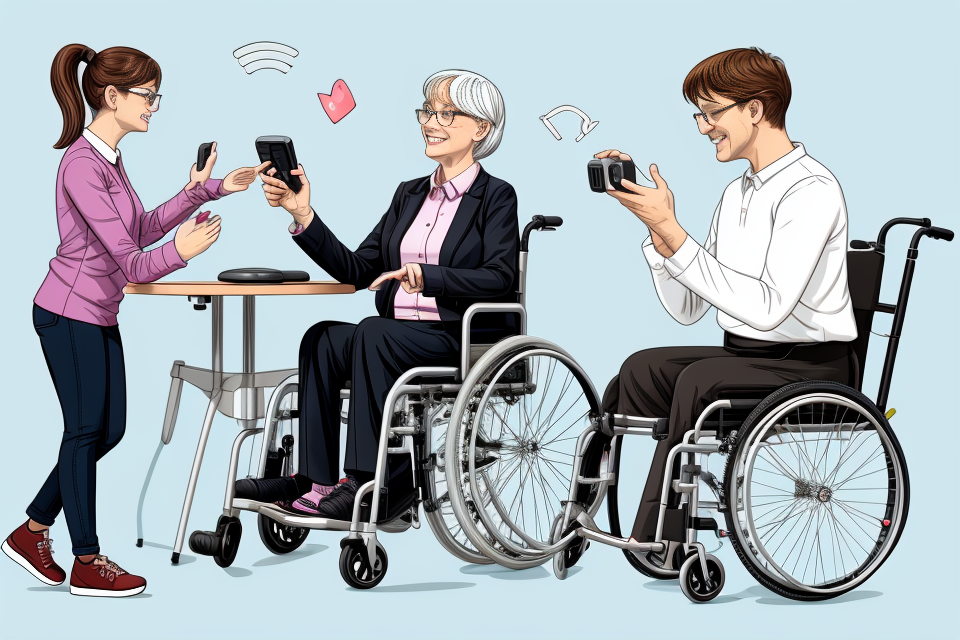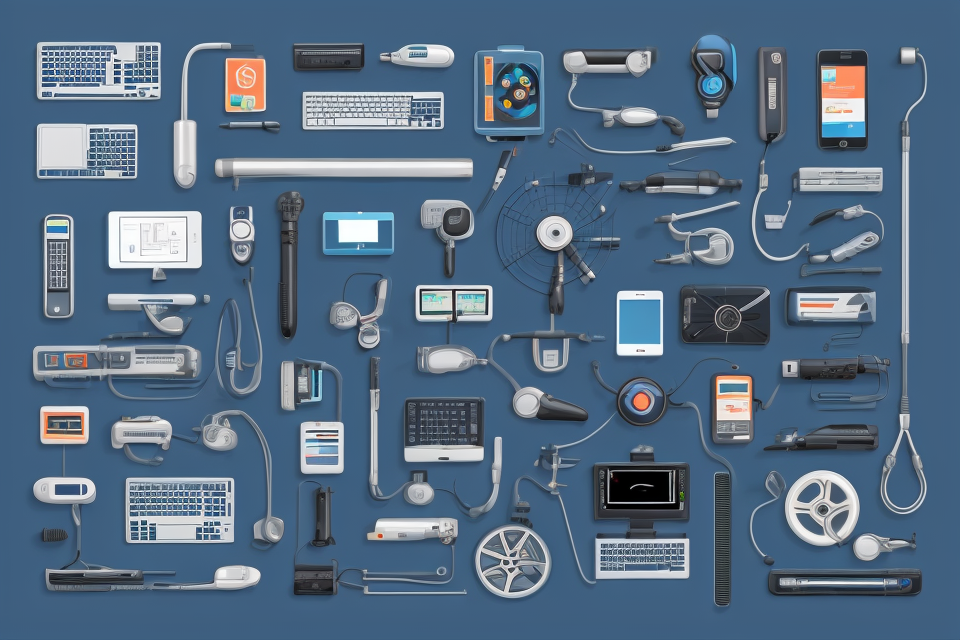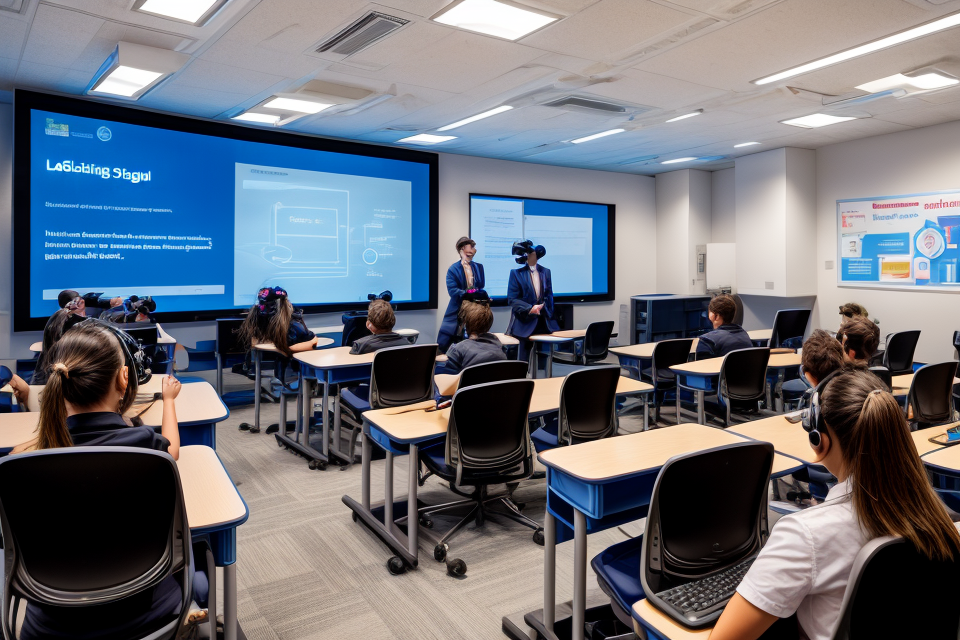
Assistive technology devices are gadgets and tools that help individuals with disabilities perform daily tasks and activities more easily. These devices are designed to enhance the independence and quality of life for people with physical, sensory, or cognitive disabilities. They can range from simple adaptive tools like specialized keyboards and mouse to advanced technologies like speech recognition software and robotics. Assistive technology devices are not only beneficial for individuals with disabilities but also for the elderly and those recovering from injuries or surgeries. With the right assistive technology device, individuals can overcome their disabilities and lead more fulfilling lives. In this article, we will explore the various types of assistive technology devices available and how they can benefit individuals with disabilities.
Assistive technology devices are tools and equipment that help individuals with disabilities perform tasks that may be difficult or impossible for them to do on their own. These devices can range from simple items like specialized keyboards and mouse to more complex technologies like speech recognition software and augmentative communication devices. Assistive technology can benefit individuals with disabilities by increasing their independence, improving their communication, and enhancing their overall quality of life. For example, a person with mobility impairments may use a power wheelchair to move around, while a person with visual impairments may use a screen reader to access digital content. Assistive technology can also help individuals with disabilities to participate more fully in education, work, and other aspects of daily life.
What are Assistive Technology Devices?
Definition of Assistive Technology Devices
Assistive technology devices are specialized tools, equipment, or software designed to help individuals with disabilities perform tasks that they might have difficulty doing on their own. These devices aim to enhance their functional abilities and independence, enabling them to live more independently and participate fully in their communities.
In essence, assistive technology devices are customized to meet the unique needs of individuals with disabilities, providing them with greater autonomy and improved quality of life. Examples of assistive technology devices include:
- Mobility aids, such as wheelchairs, walkers, and scooters
- Communication aids, such as text-to-speech software and augmentative and alternative communication (AAC) devices
- Hearing aids and cochlear implants
- Visual aids, such as magnifiers and screen readers
- Adaptive computer peripherals, such as voice recognition software and keyboard alternatives
By utilizing these devices, individuals with disabilities can overcome physical, cognitive, and sensory challenges, empowering them to achieve greater levels of self-sufficiency and social participation.
Examples of Assistive Technology Devices
Assistive technology devices are any devices or tools that are designed to help individuals with disabilities perform tasks that they may have difficulty with due to their disability. These devices can range from simple tools like a wheelchair or a hearing aid to more complex technologies like a communication aid or a computer software program.
Some examples of assistive technology devices include:
- Mobility aids: These devices are designed to help individuals with mobility impairments move around more easily. Examples include wheelchairs, walkers, and scooters.
- Communication aids: These devices are designed to help individuals with communication impairments, such as those who are deaf or hard of hearing, to communicate more effectively. Examples include text-to-speech software, augmentative communication devices, and speech-generating devices.
- Hearing aids and cochlear implants: These devices are designed to help individuals with hearing impairments to hear more clearly. Hearing aids amplify sound, while cochlear implants provide a direct electrical signal to the auditory nerve.
- Visual aids: These devices are designed to help individuals with visual impairments to see more clearly. Examples include magnifiers, screen readers, and video magnifiers.
- Memory aids: These devices are designed to help individuals with memory impairments, such as those with Alzheimer’s disease or dementia, to remember important information. Examples include medication reminders, electronic organizers, and memory aids.
Overall, assistive technology devices can greatly benefit individuals with disabilities by providing them with the tools they need to perform tasks that may otherwise be difficult or impossible for them to do.
Benefits of Assistive Technology Devices
- Improved mobility and communication
- Assistive technology devices can help individuals with disabilities to move around more easily and communicate more effectively. For example, wheelchairs, walkers, and mobility scooters can help people with mobility impairments to move around, while speech-generating devices and augmentative communication systems can help people with communication impairments to express themselves.
- Increased independence and self-sufficiency
- Assistive technology devices can enable individuals with disabilities to perform tasks that they might not be able to do otherwise. For example, adapted computer equipment and software can help people with visual impairments to use a computer, while voice-controlled assistants can help people with physical impairments to control their environment.
- Enhanced access to information and communication
- Assistive technology devices can help individuals with disabilities to access information and communicate with others more effectively. For example, screen readers can help people with visual impairments to access the internet, while captioned videos and audio descriptions can help people with hearing impairments to understand multimedia content.
- Better quality of life and improved overall health
- Assistive technology devices can improve the quality of life and overall health of individuals with disabilities. For example, assistive technology devices can help people with mobility impairments to maintain their independence and participate in social activities, which can improve their mental health and well-being. Additionally, assistive technology devices can help people with disabilities to manage their health conditions more effectively, such as by monitoring their vital signs or administering medication.
How Can Assistive Technology Devices Benefit Individuals with Disabilities?
Increased Mobility and Communication
Assistive technology devices play a vital role in improving the quality of life for individuals with disabilities by enhancing their mobility and communication abilities. These devices are specifically designed to meet the unique needs of individuals with disabilities, enabling them to perform tasks that may otherwise be challenging or impossible for them to accomplish.
In terms of increased mobility, assistive technology devices such as wheelchairs, walkers, and scooters provide individuals with mobility impairments the ability to move around more easily and independently. These devices are often customized to meet the specific needs of the user, including features such as adjustable height, seat belts, and specialized footrests. Additionally, powered wheelchairs and scooters offer even greater mobility, allowing users to navigate over various terrains and cover longer distances with ease.
Furthermore, communication aids are another type of assistive technology device that can greatly benefit individuals with speech or language impairments. These devices enable users to communicate more effectively with others, whether it be through a device that speaks for them or a device that helps them type out their messages. For example, individuals with speech impairments may use a communication aid that uses a touch screen or a grid of letters to spell out their messages. Meanwhile, those with language impairments may use a device that provides them with a visual representation of words, making it easier for them to express themselves.
Overall, assistive technology devices can greatly enhance the mobility and communication abilities of individuals with disabilities, allowing them to live more independent and fulfilling lives.
Increased Independence and Self-Sufficiency
Assistive technology devices play a vital role in helping individuals with disabilities achieve greater independence and self-sufficiency in their daily lives. These devices are specifically designed to help individuals overcome physical, cognitive, or sensory limitations, enabling them to perform tasks that might otherwise be challenging or impossible.
One of the primary benefits of assistive technology devices is their ability to enhance independence. For example, individuals with disabilities may use these devices to manage their medications, keep track of appointments, or communicate with others more effectively. By automating or simplifying these tasks, assistive technology devices can reduce the reliance on caregivers or other forms of support, thereby promoting greater independence.
Furthermore, the use of assistive technology devices can lead to a greater sense of self-worth and confidence among individuals with disabilities. By empowering them to perform tasks independently, these devices can help them overcome feelings of helplessness or dependency, enabling them to take charge of their lives and pursue their goals with greater confidence.
Additionally, the use of assistive technology devices can also improve the overall quality of life for individuals with disabilities. By reducing the stress and frustration associated with daily tasks, these devices can help individuals focus on other aspects of their lives, such as work, hobbies, or social interactions.
In conclusion, assistive technology devices can significantly benefit individuals with disabilities by promoting increased independence and self-sufficiency. By providing tools and resources that enable individuals to perform tasks more easily, these devices can help them overcome limitations and pursue their goals with greater confidence and independence.
Enhanced Access to Information and Communication
Assistive technology devices play a crucial role in enhancing the access to information and communication for individuals with disabilities. These devices are specifically designed to help individuals overcome the challenges posed by their disabilities and improve their overall quality of life. Here are some examples of how assistive technology devices can enhance access to information and communication:
- Screen Readers: Screen readers are software programs that convert text into audio, enabling individuals with visual impairments to access digital content on their computers and mobile devices. These devices use synthetic speech to read out the text, and they can also interpret other elements such as links, buttons, and icons. With the help of screen readers, individuals with visual impairments can browse the internet, read emails, and access digital documents, among other things.
- Text-to-Speech Software: Text-to-speech software is another assistive technology device that can help individuals with reading difficulties or visual impairments. This software converts written text into spoken words, making it easier for individuals to understand and process the information. Text-to-speech software can be used on computers, tablets, and smartphones, and it can be integrated with various applications such as word processors, web browsers, and e-books.
- Captioned Videos: Captioned videos are videos that have a written transcript of the audio, which can be displayed on the screen. This assistive technology device is beneficial for individuals who are deaf or hard of hearing, as it allows them to understand the content of the video. Captioned videos can be found on various platforms such as YouTube, Netflix, and Hulu, and they can also be created using video editing software.
- Braille Displays: Braille displays are devices that allow individuals with visual impairments to read and write in braille. These devices are equipped with a series of pins that raise and lower to form braille characters, and they can be connected to computers or smartphones. With the help of braille displays, individuals can access digital content such as emails, documents, and web pages in braille, making it easier for them to read and write.
Overall, assistive technology devices can greatly enhance the access to information and communication for individuals with disabilities. These devices can provide a level of independence and empowerment, enabling individuals to overcome the challenges posed by their disabilities and participate fully in society.
Better Quality of Life and Improved Overall Health
Assistive technology devices play a crucial role in enhancing the quality of life for individuals with disabilities. These devices enable individuals to perform tasks that they might otherwise struggle with, leading to a better quality of life and improved overall health. Here are some ways in which assistive technology devices can contribute to better health outcomes for individuals with disabilities:
- Increased mobility and independence: Assistive technology devices such as wheelchairs, walkers, and prosthetic limbs can help individuals with mobility impairments move around more easily, increasing their independence and reducing the risk of injuries or falls.
- Improved communication: Individuals with communication disabilities can benefit from assistive technology devices such as speech-generating devices, augmentative and alternative communication (AAC) systems, and captioned media. These devices can help individuals express their needs and desires, participate in social interactions, and communicate with healthcare providers.
- Enhanced safety: Assistive technology devices such as alerting devices, home automation systems, and safety alarms can help individuals with disabilities stay safe and prevent accidents. For example, a person with mobility impairments can use a fall detection system to alert emergency services in case of a fall.
- Greater access to information: Assistive technology devices such as screen readers, text-to-speech software, and magnification tools can help individuals with visual impairments access information and navigate digital environments. This can improve their ability to learn, work, and participate in online activities.
- Better management of chronic conditions: Assistive technology devices such as medication reminders, glucose monitors, and heart rate monitors can help individuals with chronic conditions manage their health more effectively. These devices can monitor vital signs, track medication schedules, and alert individuals to potential health issues, reducing the risk of complications and improving overall health outcomes.
Overall, assistive technology devices can have a significant positive impact on the health and well-being of individuals with disabilities. By enabling greater independence, communication, safety, and access to information, these devices can help individuals with disabilities lead more fulfilling and empowered lives.
FAQs
1. What is an assistive technology device?
An assistive technology device is any device or software that helps individuals with disabilities to perform tasks that they would otherwise be unable to do on their own. These devices can range from simple adaptive tools like specialized keyboards and mice to more complex technologies like voice recognition software and advanced prosthetics.
2. Who can benefit from assistive technology devices?
Assistive technology devices can benefit anyone with a disability, including those with physical, sensory, cognitive, or developmental disabilities. These devices can help individuals to live more independently, improve their mobility and communication, and enhance their overall quality of life.
3. What types of assistive technology devices are available?
There are many different types of assistive technology devices available, including those that help with communication, mobility, vision, hearing, and memory. Some examples include text-to-speech software, screen readers, hearing aids, and GPS devices for individuals with vision impairments.
4. How do I choose the right assistive technology device for me?
Choosing the right assistive technology device depends on your specific needs and abilities. It is important to consult with a healthcare professional or disability specialist who can help you determine which devices may be most beneficial for you. You may also want to try out different devices before making a final decision.
5. Are assistive technology devices expensive?
The cost of assistive technology devices can vary widely depending on the type of device and the extent of its capabilities. Some devices may be covered by insurance or available at no cost through government programs or non-profit organizations. It is important to explore all available options to find the most affordable solution for your needs.


